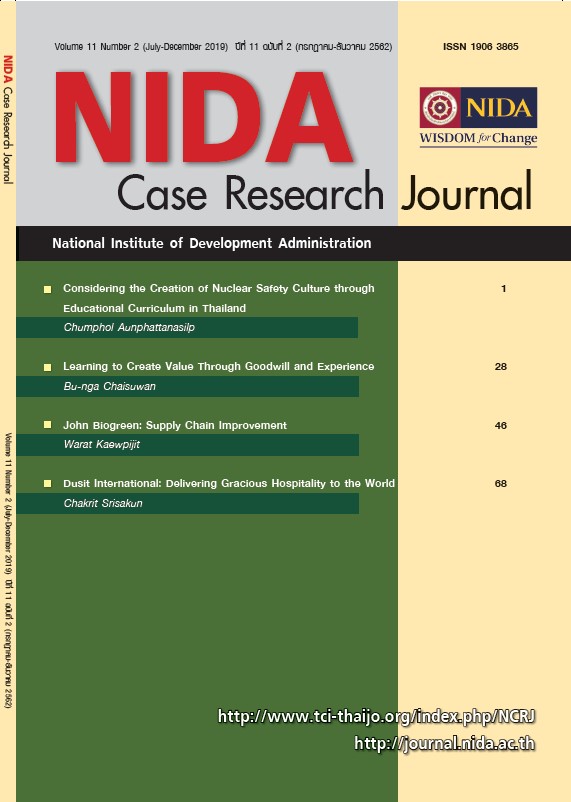John Biogreen: Supply Chain Improvement
Keywords:
Biomass Power Plant, Supply Chain Management, Supply Chain DesignAbstract
In April 2016, Pratchya Sae-Ngo, director of logistics of NK Energy (NKE), faced a challenge regarding the supply chain of the company’s newly-acquired biomass power plant, John Biogreen (JB), which was in a dire situation since the total supply chain cost accounted for more than 90% of its revenue, significantly higher compared to their first plant. NKE was a small power producer (SPP) located in Nakhon Pathom province. The company operates an 8MW biomass power plant with rice husks as the main fuel. In 2016, they decided to acquire JB, which is a biomass power plant located in Suphanburi and that has similar technical specifications, yet the performance of JB is relatively lower. They discovered that the failure of JB was a result of its poorly-designed supply chain. On average, JB has higher material costs than NKE and a lower than average inventory level. Thus, Somchai arranged for Pratchaya to redesign the supply chain of JB. His objective was to reduce the supply chain cost and to ensure continuous feedstock. After analyzing the supply chain of JB, Pratchaya found that the problem lay in its small supplier base, insufficient inventory, and low flexibility in transportation. There were several alternatives in solving those issues and Pratchaya had to analyze and combine them in order to create a new supply chain for JB. He only had 2 months to finalize his new supply chain design before the quarterly meeting of the company, which was to be held on June 1, for approval since the implementation of the redesigned supply chain had to be completed before the next harvesting season.
References
Adams, P. W., Hammond, G. P., McManus, M. C., & Mezzullo, W. G. (2011). Barriers toand drivers for UK bioenergy development. Renewable and Sustainable Energy Reviews, 15(2), 1217-1227. doi:https://doi.org/10.1016/j.rser.2010.09.039
Energy Policy and Planning Office. (2017). Energy Statistics of Thailand 2017. Retrieved from http://www.eppo.go.th/index.php/th/informationservices/ct-menu-item-56?orders[publishUp]=publishUp&issearch=1
Iakovou, E., Karagiannidis, A., Vlachos, D., Toka, A., & Malamakis, A. (2010). Waste biomass-to-energy supply chain management: A critical synthesis. Waste Management, 30(10), 1860-1870. doi:https://doi.org/10.1016/j.wasman. 2010.02.030
Kanzian, C., Holzleitner, F., Stampfer, K., Kanzian, S., & Ashton, K. (2009). Regional Energy Wood Logistics - Optimizing Local Fuel Supply. Silva Fennica, 43. doi:10.14214/sf.464
Nilsson, D., & Hansson, P. A. (2001). Influence of various machinery combinations, fuel proportions and storage capacities on costs for co-handling of straw and reed canary grass to district heating plants. Biomass and Bioenergy, 20(4), 247-260. doi:https://doi.org/10.1016/S0961-9534(00)00077-5
Rentizelas, A. A., Tolis, A. J., & Tatsiopoulos, I. P. (2009). Logistics issues of biomass: The storage problem and the multi-biomass supply chain. Renewable and Sustainable Energy Reviews, 13(4), 887-894. doi:https://doi.org/10.1016/j.rser.2008.01.003
Saidur, R., Abdelaziz, E. A., Demirbas, A., Hossain, M. S., & Mekhilef, S. (2011). A review on biomass as a fuel for boilers. Renewable and Sustainable Energy Reviews, 15(5), 2262-2289. doi:https://doi.org/10.1016/j.rser.2011.02.015
Tatsiopoulos, I. P., & Tolis, A. J. (2003). Economic aspects of the cotton-stalk biomass logistics and comparison of supply chain methods. Biomass and Bioenergy, 24(3), 199-214. doi:https://doi.org/10.1016/S0961-9534(02)00115-0
Thornley, P. (2006). Increasing biomass based power generation in the UK. Energy Policy, 34(15), 2087-2099. doi:https://doi.org/10.1016/j.enpol.2005.02.006
Downloads
Published
How to Cite
Issue
Section
License
Copyright (c) 2020 NIDA Case Research Journal

This work is licensed under a Creative Commons Attribution-NonCommercial-NoDerivatives 4.0 International License.





